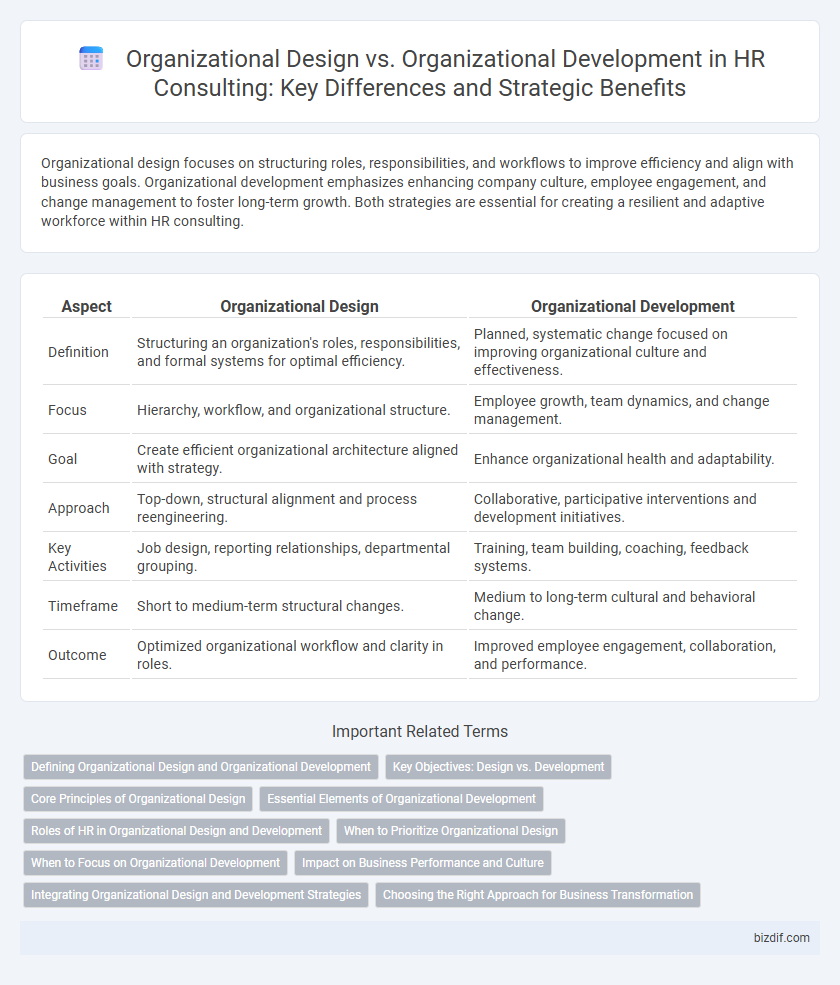Organizational design focuses on structuring roles, responsibilities, and workflows to improve efficiency and align with business goals. Organizational development emphasizes enhancing company culture, employee engagement, and change management to foster long-term growth. Both strategies are essential for creating a resilient and adaptive workforce within HR consulting.
Table of Comparison
| Aspect | Organizational Design | Organizational Development |
|---|---|---|
| Definition | Structuring an organization's roles, responsibilities, and formal systems for optimal efficiency. | Planned, systematic change focused on improving organizational culture and effectiveness. |
| Focus | Hierarchy, workflow, and organizational structure. | Employee growth, team dynamics, and change management. |
| Goal | Create efficient organizational architecture aligned with strategy. | Enhance organizational health and adaptability. |
| Approach | Top-down, structural alignment and process reengineering. | Collaborative, participative interventions and development initiatives. |
| Key Activities | Job design, reporting relationships, departmental grouping. | Training, team building, coaching, feedback systems. |
| Timeframe | Short to medium-term structural changes. | Medium to long-term cultural and behavioral change. |
| Outcome | Optimized organizational workflow and clarity in roles. | Improved employee engagement, collaboration, and performance. |
Defining Organizational Design and Organizational Development
Organizational design involves structuring roles, responsibilities, and systems to align with a company's strategic goals, optimizing workflow and hierarchy. Organizational development focuses on enhancing organizational effectiveness through planned interventions in culture, processes, and employee engagement. Both disciplines are critical for driving sustained business growth and adaptability in competitive markets.
Key Objectives: Design vs. Development
Organizational design centers on structuring roles, responsibilities, and workflows to enhance efficiency and align with strategic goals, emphasizing clarity and scalability. Organizational development focuses on improving culture, employee engagement, and change management to foster continuous growth and adaptability. Effective HR consulting integrates both by aligning structural frameworks with human capital development to drive sustainable organizational success.
Core Principles of Organizational Design
Organizational design focuses on structuring roles, responsibilities, and workflows to align with business goals, emphasizing clarity, efficiency, and scalability. Core principles include defining clear reporting lines, fostering collaboration through cross-functional teams, and ensuring adaptability to market changes. This contrasts with organizational development, which centers on improving culture, employee engagement, and change management processes.
Essential Elements of Organizational Development
Organizational development focuses on enhancing a company's capacity for change and improving overall effectiveness through strategic interventions such as team building, leadership development, and process improvement. Essential elements of organizational development include continuous feedback mechanisms, employee involvement, and data-driven decision-making to foster a culture of learning and adaptability. This contrasts with organizational design, which primarily addresses the structural framework by defining roles, hierarchies, and workflows.
Roles of HR in Organizational Design and Development
HR plays a crucial role in organizational design by defining job roles, establishing reporting structures, and aligning workforce capabilities with business strategy to enhance efficiency. In organizational development, HR drives change management, facilitates employee training programs, and promotes a culture of continuous improvement to boost overall organizational performance. Both functions require HR to analyze current processes, identify gaps, and implement targeted interventions that support sustainable growth and adaptability.
When to Prioritize Organizational Design
Organizational design should be prioritized when a company is undergoing significant structural changes such as mergers, rapid growth, or shifts in strategic direction that require clear roles, responsibilities, and reporting lines to enhance efficiency. It is essential to address organizational design before embarking on organizational development initiatives to ensure the foundational framework supports talent management and cultural transformation effectively. By focusing on organizational design first, businesses create a scalable structure that drives sustained performance and aligns with long-term strategic goals.
When to Focus on Organizational Development
Organizational development should be prioritized when a company faces cultural challenges, employee engagement issues, or requires change management to improve overall effectiveness. It focuses on long-term strategies to enhance organizational health through training, leadership development, and team-building interventions. Unlike organizational design, which addresses structural changes, organizational development targets behavioral and process improvements to foster sustainable growth.
Impact on Business Performance and Culture
Organizational design optimizes business performance by structuring roles, workflows, and communication channels to enhance efficiency and strategic alignment. Organizational development fosters a strong company culture through continuous learning, change management, and employee engagement initiatives. Together, these approaches drive sustainable growth by improving operational effectiveness and nurturing a positive workplace environment.
Integrating Organizational Design and Development Strategies
Integrating organizational design and development strategies enhances company agility by aligning structure with culture and processes, fostering innovation and employee engagement. Effective collaboration between these approaches ensures that structural changes support ongoing development initiatives, optimizing workforce capabilities and productivity. Leveraging data-driven insights in both design and development phases tailors solutions to specific business goals, accelerating transformation outcomes.
Choosing the Right Approach for Business Transformation
Organizational design focuses on structuring roles, workflows, and hierarchies to optimize efficiency, while organizational development emphasizes culture, employee engagement, and change management for sustainable growth. Choosing the right approach depends on business goals, whether the priority is on operational alignment or fostering adaptive capabilities. Integrating both strategies can drive comprehensive business transformation by aligning structural efficiency with human capital development.
organizational design vs organizational development Infographic

 bizdif.com
bizdif.com